TOYOTA RAV4 2006 Service Repair Manual
Manufacturer: TOYOTA, Model Year: 2006, Model line: RAV4, Model: TOYOTA RAV4 2006Pages: 2000, PDF Size: 45.84 MB
Page 1991 of 2000
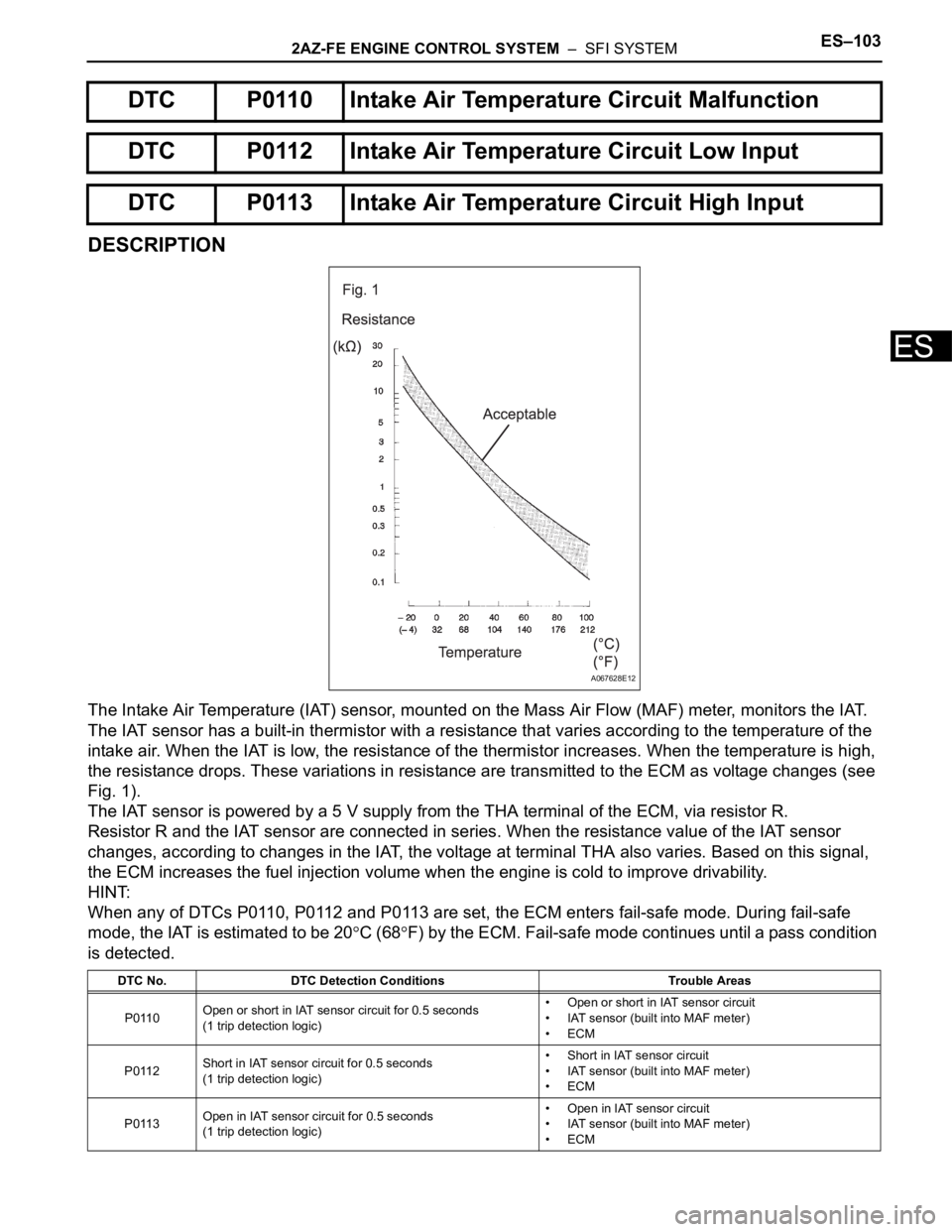
2AZ-FE ENGINE CONTROL SYSTEM – SFI SYSTEMES–103
ES
DESCRIPTION
The Intake Air Temperature (IAT) sensor, mounted on the Mass Air Flow (MAF) meter, monitors the IAT.
The IAT sensor has a built-in thermistor with a resistance that varies according to the temperature of the
intake air. When the IAT is low, the resistance of the thermistor increases. When the temperature is high,
the resistance drops. These variations in resistance are transmitted to the ECM as voltage changes (see
Fig. 1).
The IAT sensor is powered by a 5 V supply from the THA terminal of the ECM, via resistor R.
Resistor R and the IAT sensor are connected in series. When the resistance value of the IAT sensor
changes, according to changes in the IAT, the voltage at terminal THA also varies. Based on this signal,
the ECM increases the fuel injection volume when the engine is cold to improve drivability.
HINT:
When any of DTCs P0110, P0112 and P0113 are set, the ECM enters fail-safe mode. During fail-safe
mode, the IAT is estimated to be 20
C (68F) by the ECM. Fail-safe mode continues until a pass condition
is detected.
DTC P0110 Intake Air Temperature Circuit Malfunction
DTC P0112 Intake Air Temperature Circuit Low Input
DTC P0113 Intake Air Temperature Circuit High Input
DTC No. DTC Detection Conditions Trouble Areas
P0110Open or short in IAT sensor circuit for 0.5 seconds
(1 trip detection logic)• Open or short in IAT sensor circuit
• IAT sensor (built into MAF meter)
•ECM
P0112Short in IAT sensor circuit for 0.5 seconds
(1 trip detection logic)• Short in IAT sensor circuit
• IAT sensor (built into MAF meter)
•ECM
P0113Open in IAT sensor circuit for 0.5 seconds
(1 trip detection logic)• Open in IAT sensor circuit
• IAT sensor (built into MAF meter)
•ECM
A067628E12
Page 1992 of 2000

ES–1042AZ-FE ENGINE CONTROL SYSTEM – SFI SYSTEM
ES
HINT:
When any of these DTCs are set, check the IAT by selecting the following menu items on the intelligent
tester: DIAGNOSIS / ENHANCED OBD II / DATA LIST / PRIMARY / INTAKE AIR.
MONITOR DESCRIPTION
The ECM monitors the sensor voltage and uses this value to calculate the IAT. When the sensor output
voltage deviates from the normal operating range, the ECM interprets this as a malfunction in the IAT
sensor and sets a DTC.
Example:
If the sensor output voltage is more than 4.91 V for 0.5 seconds or more, the ECM determines that there
is an open in the IAT sensor circuit, and sets DTC P0113. Conversely, if the output voltage is less than
0.18 V for 0.5 seconds or more, the ECM determines that there is a short in the sensor circuit, and sets
DTC P0112.
If the malfunction is not repaired successfully, a DTC is set 0.5 seconds after the engine is next started.
MONITOR STRATEGY
TYPICAL ENABLING CONDITIONS
TYPICAL MALFUNCTION THRESHOLDS
P0110:
P0112:
P0113:
COMPONENT OPERATING RANGE
Temperature Displayed Malfunctions
-40
C (-40F) Open circuit
140
C (284F) or higher Short circuit
Related DTCsP0110: IAT sensor range check (Fluctuating)
P0112: IAT sensor range check (Low voltage)
P0113: IAT sensor range check (High voltage)
Required Sensors/Components (Main) IAT sensor
Required Sensors/Components (Related) -
Frequency of Operation Continuous
Duration 0.5 seconds
MIL Operation Immediate
Sequence of Operation None
Monitor runs whenever following DTCs not present None
IAT sensor voltage Less than 0.18 V, or more than 4.91 V
IAT sensor voltage [IAT] Less than 0.18 V [More than 140
C (284F)]
IAT sensor voltage [IAT] More than 4.91 V [Less than -40
C (-40F)]
IAT sensor voltage [IAT] 0.18 to 4.91 V [-40
C to 140C (-40F to 284F)]
Page 1993 of 2000
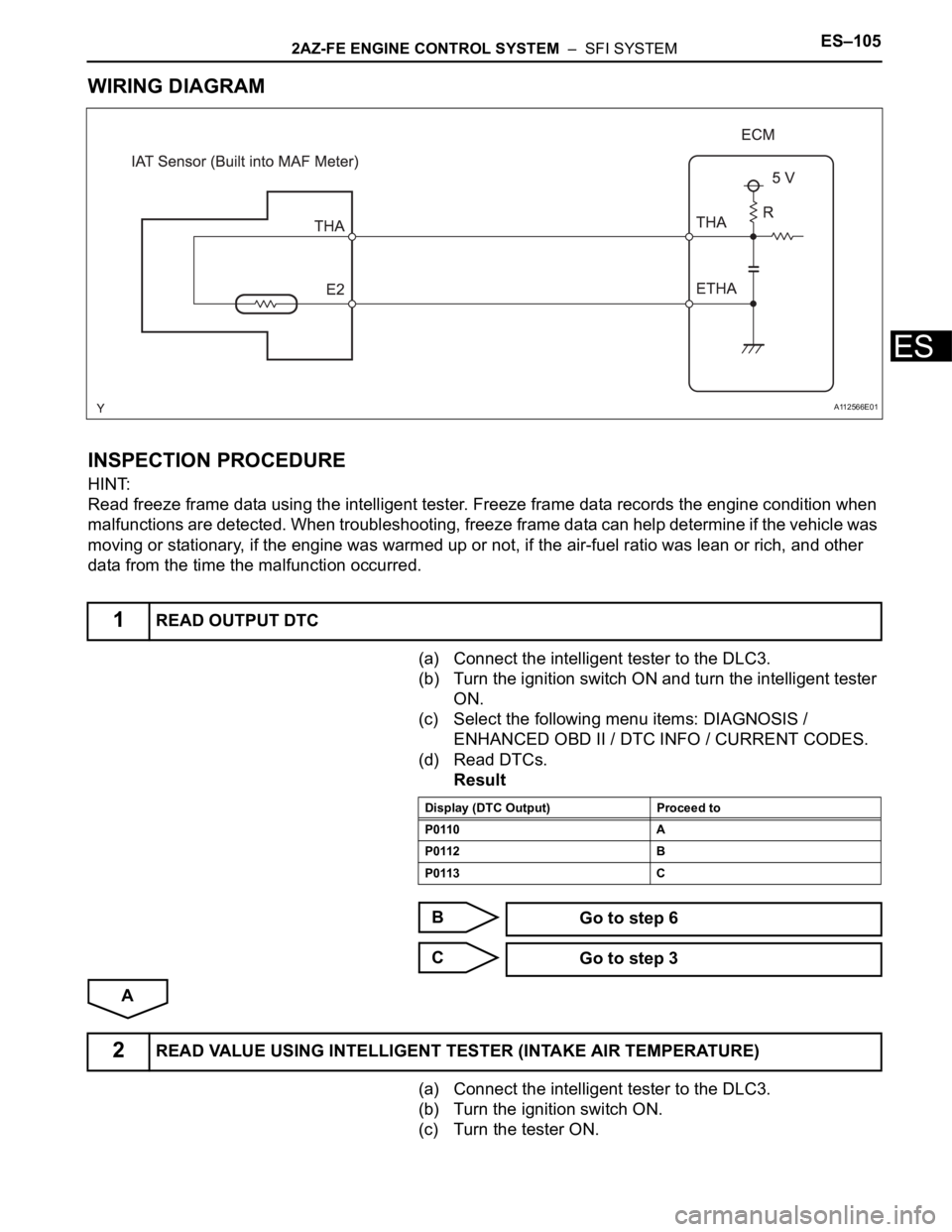
2AZ-FE ENGINE CONTROL SYSTEM – SFI SYSTEMES–105
ES
WIRING DIAGRAM
INSPECTION PROCEDURE
HINT:
Read freeze frame data using the intelligent tester. Freeze frame data records the engine condition when
malfunctions are detected. When troubleshooting, freeze frame data can help determine if the vehicle was
moving or stationary, if the engine was warmed up or not, if the air-fuel ratio was lean or rich, and other
data from the time the malfunction occurred.
(a) Connect the intelligent tester to the DLC3.
(b) Turn the ignition switch ON and turn the intelligent tester
ON.
(c) Select the following menu items: DIAGNOSIS /
ENHANCED OBD II / DTC INFO / CURRENT CODES.
(d) Read DTCs.
Result
B
C
A
(a) Connect the intelligent tester to the DLC3.
(b) Turn the ignition switch ON.
(c) Turn the tester ON.
1READ OUTPUT DTC
A112566E01
Display (DTC Output) Proceed to
P0110 A
P0112 B
P0113 C
Go to step 6
Go to step 3
2READ VALUE USING INTELLIGENT TESTER (INTAKE AIR TEMPERATURE)
Page 1994 of 2000
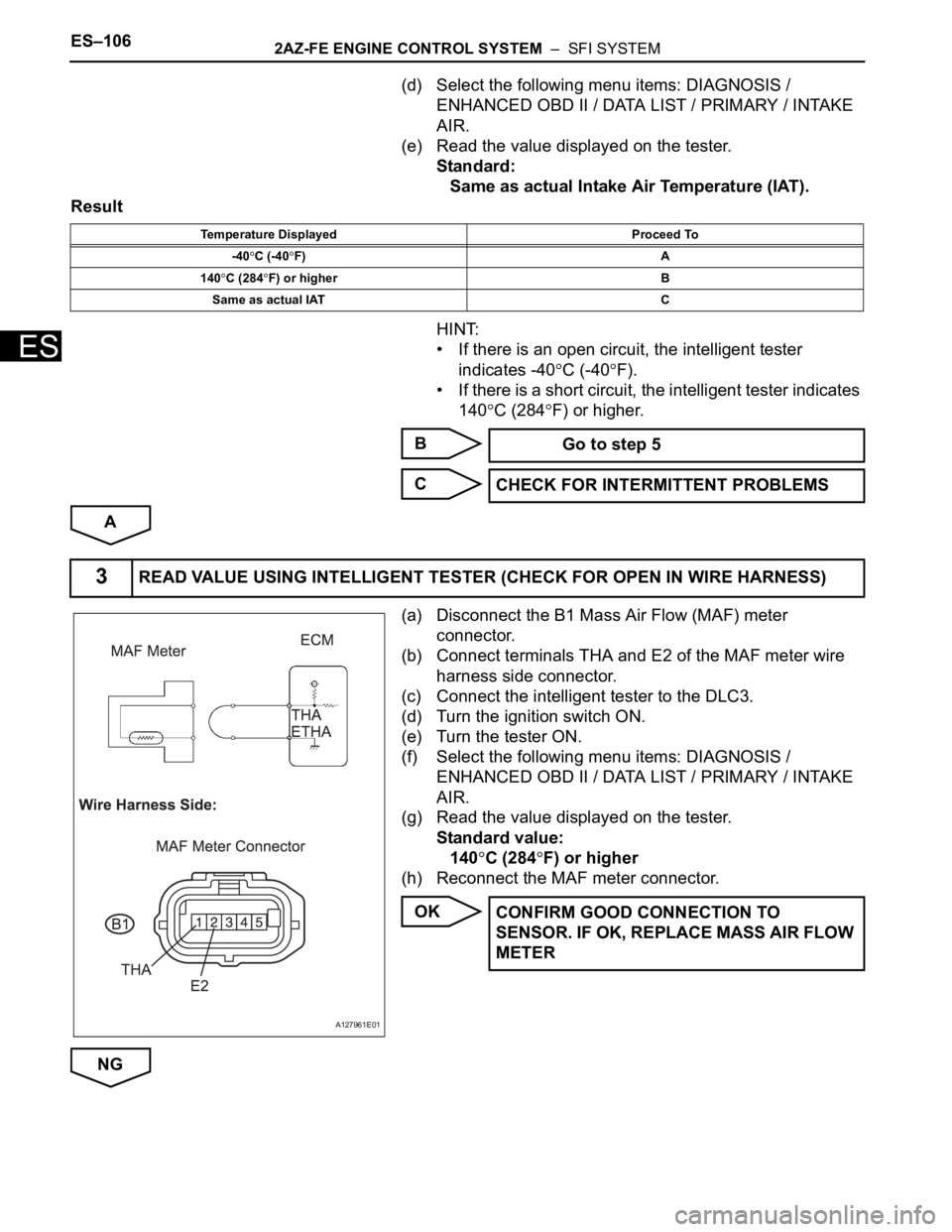
ES–1062AZ-FE ENGINE CONTROL SYSTEM – SFI SYSTEM
ES
(d) Select the following menu items: DIAGNOSIS /
ENHANCED OBD II / DATA LIST / PRIMARY / INTAKE
AIR.
(e) Read the value displayed on the tester.
Standard:
Same as actual Intake Air Temperature (IAT).
Result
HINT:
• If there is an open circuit, the intelligent tester
indicates -40
C (-40F).
• If there is a short circuit, the intelligent tester indicates
140
C (284F) or higher.
B
C
A
(a) Disconnect the B1 Mass Air Flow (MAF) meter
connector.
(b) Connect terminals THA and E2 of the MAF meter wire
harness side connector.
(c) Connect the intelligent tester to the DLC3.
(d) Turn the ignition switch ON.
(e) Turn the tester ON.
(f) Select the following menu items: DIAGNOSIS /
ENHANCED OBD II / DATA LIST / PRIMARY / INTAKE
AIR.
(g) Read the value displayed on the tester.
Standard value:
140
C (284F) or higher
(h) Reconnect the MAF meter connector.
OK
NG
Temperature Displayed Proceed To
-40
C (-40F) A
140
C (284F) or higher B
Same as actual IAT C
Go to step 5
CHECK FOR INTERMITTENT PROBLEMS
3READ VALUE USING INTELLIGENT TESTER (CHECK FOR OPEN IN WIRE HARNESS)
A127961E01
CONFIRM GOOD CONNECTION TO
SENSOR. IF OK, REPLACE MASS AIR FLOW
METER
Page 1995 of 2000
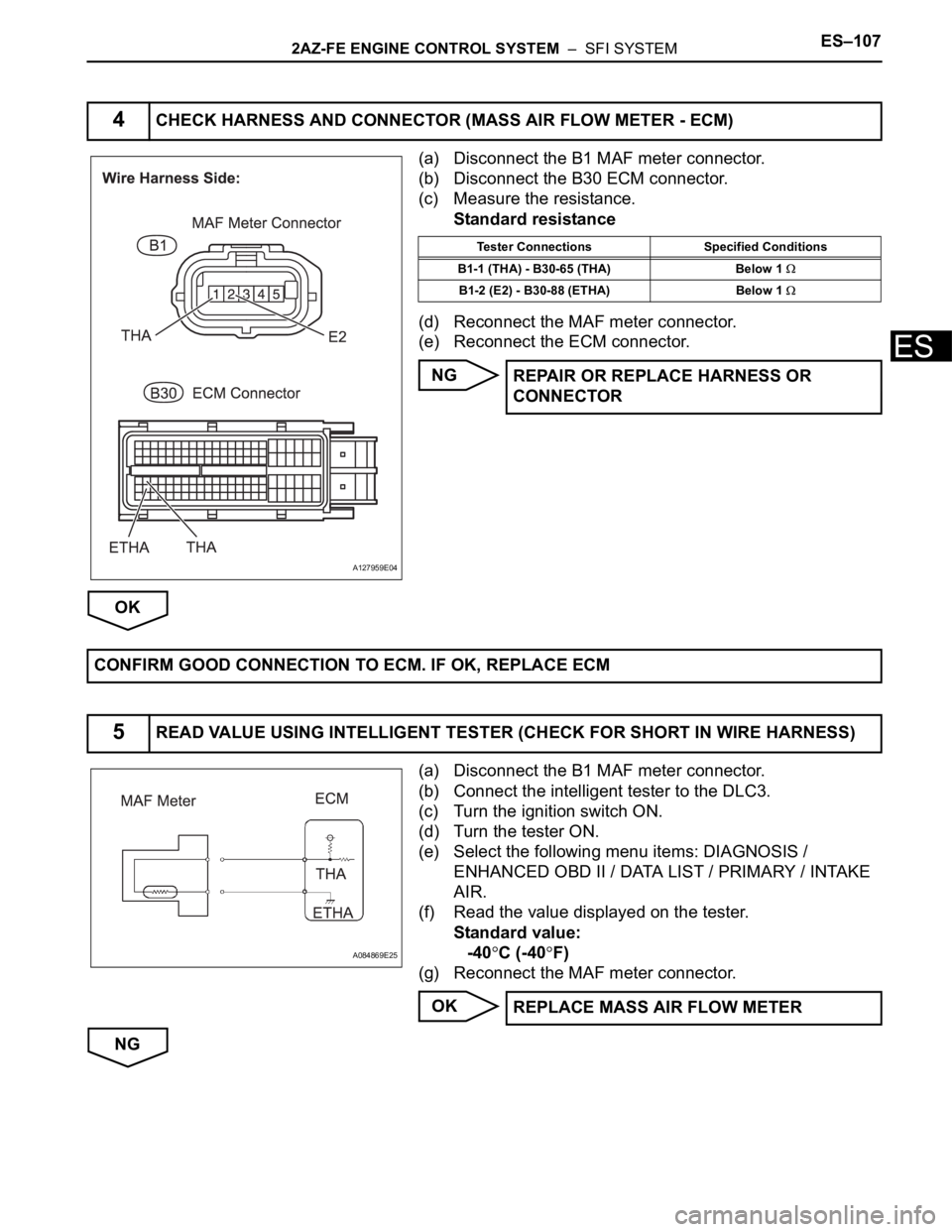
2AZ-FE ENGINE CONTROL SYSTEM – SFI SYSTEMES–107
ES
(a) Disconnect the B1 MAF meter connector.
(b) Disconnect the B30 ECM connector.
(c) Measure the resistance.
Standard resistance
(d) Reconnect the MAF meter connector.
(e) Reconnect the ECM connector.
NG
OK
(a) Disconnect the B1 MAF meter connector.
(b) Connect the intelligent tester to the DLC3.
(c) Turn the ignition switch ON.
(d) Turn the tester ON.
(e) Select the following menu items: DIAGNOSIS /
ENHANCED OBD II / DATA LIST / PRIMARY / INTAKE
AIR.
(f) Read the value displayed on the tester.
Standard value:
-40
C (-40F)
(g) Reconnect the MAF meter connector.
OK
NG
4CHECK HARNESS AND CONNECTOR (MASS AIR FLOW METER - ECM)
A127959E04
Tester Connections Specified Conditions
B1-1 (THA) - B30-65 (THA) Below 1
B1-2 (E2) - B30-88 (ETHA) Below 1
REPAIR OR REPLACE HARNESS OR
CONNECTOR
CONFIRM GOOD CONNECTION TO ECM. IF OK, REPLACE ECM
5READ VALUE USING INTELLIGENT TESTER (CHECK FOR SHORT IN WIRE HARNESS)
A084869E25
REPLACE MASS AIR FLOW METER
Page 1996 of 2000
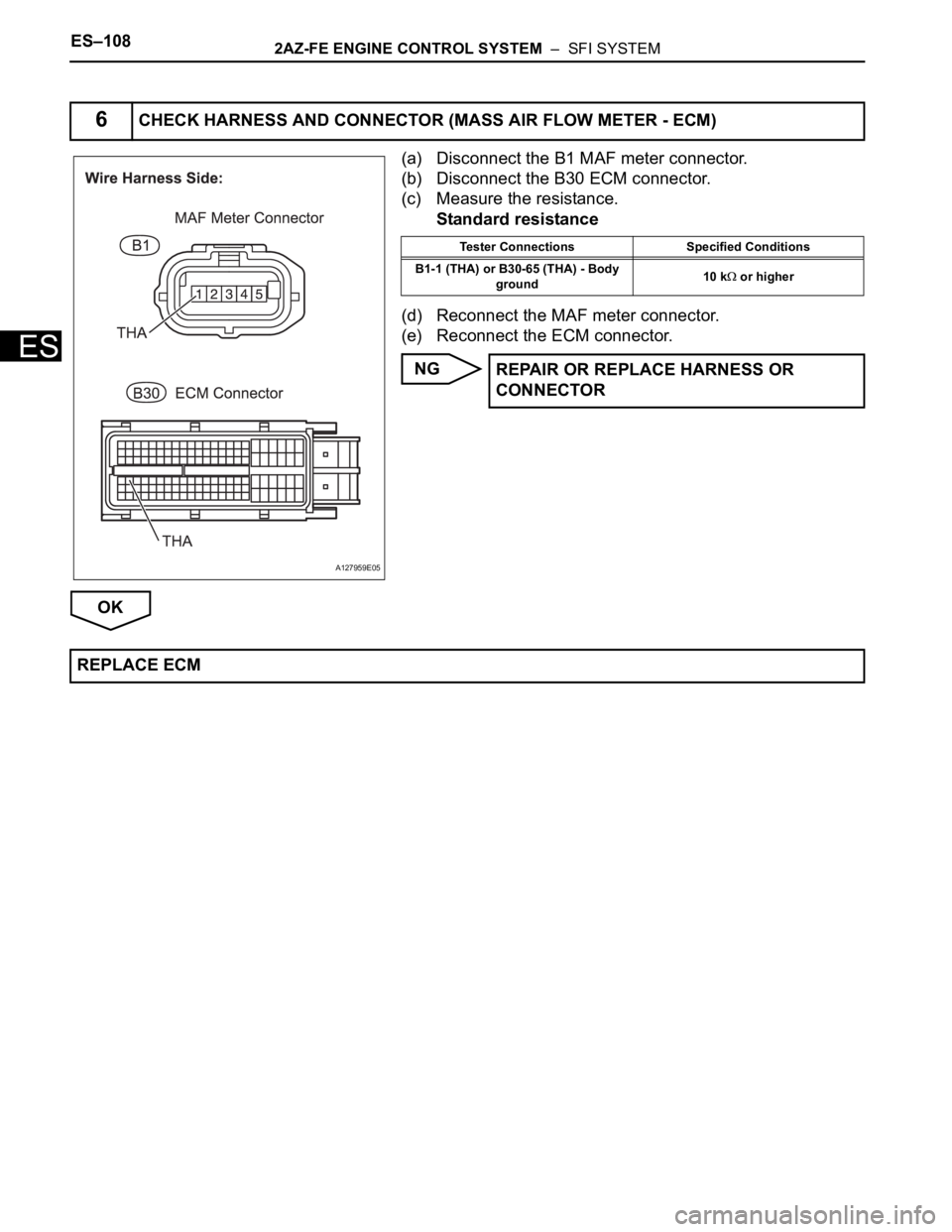
ES–1082AZ-FE ENGINE CONTROL SYSTEM – SFI SYSTEM
ES
(a) Disconnect the B1 MAF meter connector.
(b) Disconnect the B30 ECM connector.
(c) Measure the resistance.
Standard resistance
(d) Reconnect the MAF meter connector.
(e) Reconnect the ECM connector.
NG
OK
6CHECK HARNESS AND CONNECTOR (MASS AIR FLOW METER - ECM)
A127959E05
Tester Connections Specified Conditions
B1-1 (THA) or B30-65 (THA) - Body
ground10 k
or higher
REPAIR OR REPLACE HARNESS OR
CONNECTOR
REPLACE ECM
Page 1997 of 2000
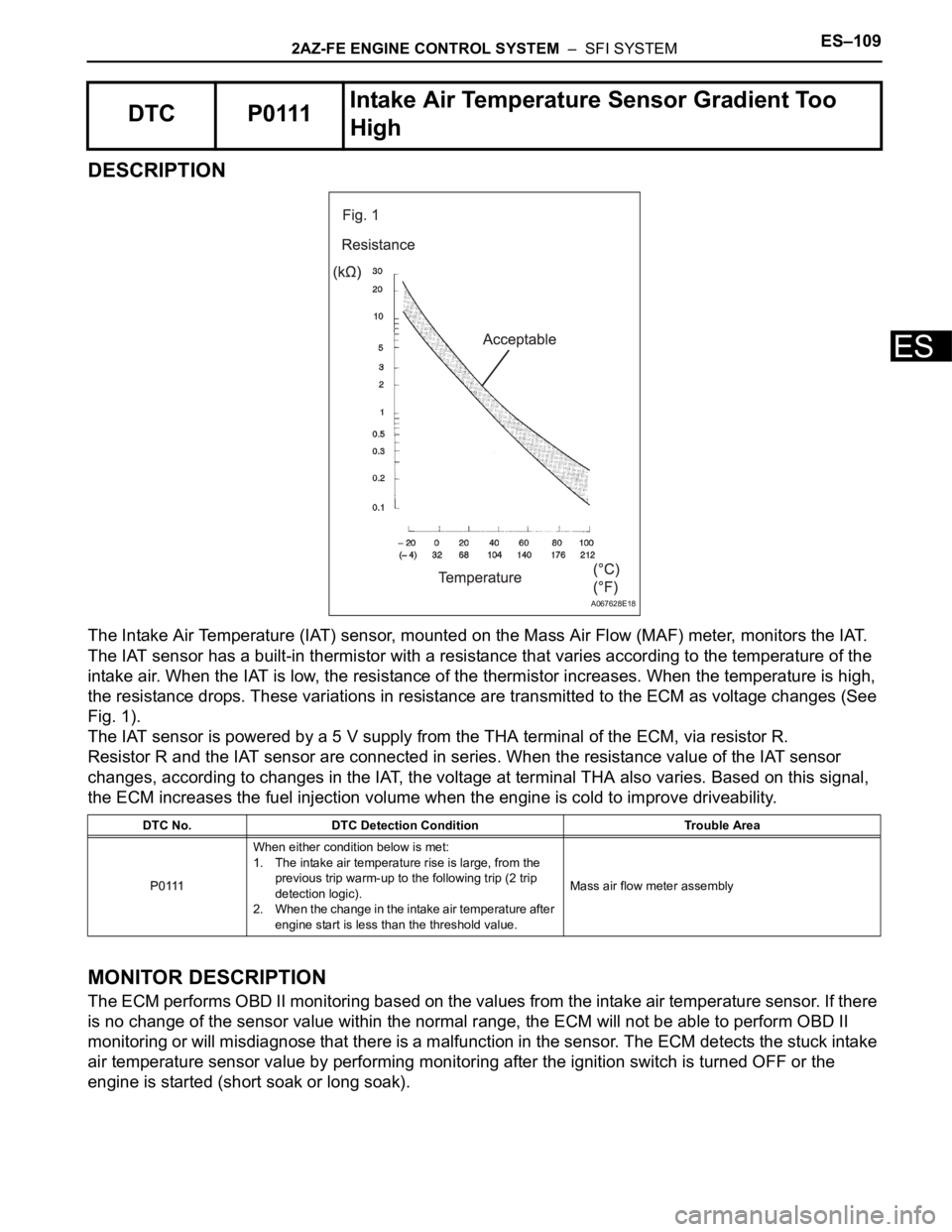
2AZ-FE ENGINE CONTROL SYSTEM – SFI SYSTEMES–109
ES
DESCRIPTION
The Intake Air Temperature (IAT) sensor, mounted on the Mass Air Flow (MAF) meter, monitors the IAT.
The IAT sensor has a built-in thermistor with a resistance that varies according to the temperature of the
intake air. When the IAT is low, the resistance of the thermistor increases. When the temperature is high,
the resistance drops. These variations in resistance are transmitted to the ECM as voltage changes (See
Fig. 1).
The IAT sensor is powered by a 5 V supply from the THA terminal of the ECM, via resistor R.
Resistor R and the IAT sensor are connected in series. When the resistance value of the IAT sensor
changes, according to changes in the IAT, the voltage at terminal THA also varies. Based on this signal,
the ECM increases the fuel injection volume when the engine is cold to improve driveability.
MONITOR DESCRIPTION
The ECM performs OBD II monitoring based on the values from the intake air temperature sensor. If there
is no change of the sensor value within the normal range, the ECM will not be able to perform OBD II
monitoring or will misdiagnose that there is a malfunction in the sensor. The ECM detects the stuck intake
air temperature sensor value by performing monitoring after the ignition switch is turned OFF or the
engine is started (short soak or long soak).
DTC P0111Intake Air Temperature Sensor Gradient Too
High
DTC No. DTC Detection Condition Trouble Area
P0111When either condition below is met:
1. The intake air temperature rise is large, from the
previous trip warm-up to the following trip (2 trip
detection logic).
2. When the change in the intake air temperature after
engine start is less than the threshold value.Mass air flow meter assembly
A067628E18
Page 1998 of 2000

ES–1102AZ-FE ENGINE CONTROL SYSTEM – SFI SYSTEM
ES
MONITOR STRATEGY
TYPICAL ENABLING CONDITIONS
All:
After engine stop:
After cold engine start:
TYPICAL MALFUNCTION THRESHOLDS
After engine stop:
After cold engine start:
WIRING DIAGRAM
Refer to DTC P0110 (see page ES-88).
INSPECTION PROCEDURE
(a) Connect the intelligent tester to the DLC3.
Related DTCsP0111: Intake air temperature sensor rationality (After engine stop)
P0111: Intake air temperature sensor rationality (After cold engine
start)
Required Sensors/Components (Main) Intake Air Temperature (IAT) sensor
Required Sensors/Components (Sub) -
Frequency of Operation Once per driving cycle
Duration 5 hours or more
MIL Operation 2 driving cycles
Sequence of Operation None
Monitor runs whenever following DTCs are not present None
Time after engine start 10 seconds or more
Battery voltage 10.5 V or more
ECT sensor circuit OK
ECT change since engine Less than 180
C (356F)
ECT before engine stop 70
C (158F) or more
Time that MAF is low before engine stop 70 minutes
Accumulated MAF amount before engine stop 3,451 g or more
Key-off duration 30 minutes
Key-off duration 5 hours
Time after engine start 10 seconds or more
ECT sensor circuit OK
ECT 70
C (158F) or more
Accumulated MAF amount 3,451 g or more
One of the following conditions 1 or 2 is met: -
1. Duration while engine load is low 120 seconds or more
2. Duration while engine load is high 10 seconds or more
IAT change Less than 1
C (2F)
IAT change Less than 1
C (2F)
1CHECK ANY OTHER DTCS OUTPUT (IN ADDITION TO DTC P0111)
Page 1999 of 2000

2AZ-FE ENGINE CONTROL SYSTEM – SFI SYSTEMES–111
ES
(b) Turn the ignition switch ON.
(c) Turn the tester ON.
(d) Enter the following menus: DIAGNOSIS / ENHANCED
OBD II / DTC INFO / CURRENT CODES.
(e) Read DTCs.
Result
HINT:
If any DTCs other than P0111 are output, troubleshoot
those DTCs first.
B
A
Display (DTC Output) Proceed to
P0111 and other DTCs A
P0111 B
REPLACE MASS AIR FLOW METER
GO TO DTC CHART
Page 2000 of 2000

ES–1122AZ-FE ENGINE CONTROL SYSTEM – SFI SYSTEM
ES
DESCRIPTION
A thermistor, whose resistance value varies according to the ECT, is built into the Engine Coolant
Temperature (ECT) sensor.
The structure of the sensor and its connection to the ECM are the same as those of the Intake Air
Temperature (IAT) sensor.
HINT:
When any of DTCs P0115, P0117 and P0118 are set, the ECM enters fail-safe mode. During fail-safe
mode, the ECT is estimated to be 80
C (176F) by the ECM. Fail-safe mode continues until a pass
condition is detected.
HINT:
When any of these DTCs are set, check the ECT by selecting the following menu items on the intelligent
tester: DIAGNOSIS / ENHANCED OBD II / DATA LIST / PRIMARY / COOLANT TEMP.
MONITOR DESCRIPTION
The Engine Coolant Temperature (ECT) sensor is used to monitor the ECT. The ECT sensor has a
thermistor with a resistance that varies according to the temperature of the engine coolant. When the
coolant temperature is low, the resistance in the thermistor increases. When the temperature is high, the
resistance drops. These variations in resistance are reflected in the output voltage from the sensor. The
ECM monitors the sensor voltage and uses this value to calculate the ECT. When the sensor output
voltage deviates from the normal operating range, the ECM interprets this as a fault in the ECT sensor
and sets a DTC.
Example:
If the sensor output voltage is more than 4.91 V for 0.5 seconds or more, the ECM determines that there
is an open in the ECT sensor circuit, and sets DTC P0118. Conversely, if the voltage output is less than
0.14 V for 0.5 seconds or more, the ECM determines that there is a short in the sensor circuit, and sets
DTC P0117.
If the malfunction is not repaired successfully, a DTC is set 0.5 seconds after the engine is next started.
DTC P0115Engine Coolant Temperature Circuit Malfunc-
tion
DTC P0117 Engine Coolant Temperature Circuit Low Input
DTC P0118 Engine Coolant Temperature Circuit High Input
DTC No. DTC Detection Conditions Trouble Areas
P0115Open or short in ECT sensor circuit for 0.5 seconds (1 trip
detection logic)• Open or short in ECT sensor circuit
• ECT sensor
•ECM
P0117Short in ECT sensor circuit for 0.5 seconds (1 trip detection
logic)• Short in ECT sensor
• ECT sensor
•ECM
P0118Open in ECT sensor circuit for 0.5 seconds (1 trip detection
logic)• Open in ECT sensor circuit
• ECT sensor
•ECM
Temperature Displayed Malfunctions
-40
C (-40F) Open circuit
140
C (284F) or higher Short circuit